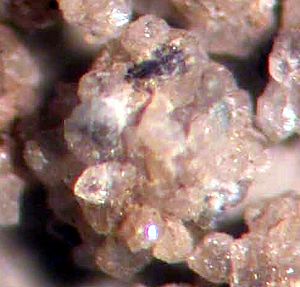Dunvegan Formation facts for kids
Quick facts for kids Dunvegan FormationStratigraphic range: Cenomanian ~99–94Ma |
|
|---|---|

Dunvegan Sandstone
|
|
| Type | Geological formation |
| Underlies | Smoky Group |
| Overlies | Fort St. John Group (Shaftesbury Formation) |
| Thickness | up to 380 feet (120 m) |
| Lithology | |
| Primary | Sandstone |
| Other | Shale |
| Location | |
| Coordinates | 55°55′14″N 118°37′55″W / 55.92043°N 118.63203°W |
| Region | Northeast Northwest |
| Country | |
| Type section | |
| Named for | Dunvegan, Alberta |
| Named by | George Mercer Dawson |
| Year defined | 1881 |
The Dunvegan Formation is a special layer of rock found in western Canada. It formed a very long time ago, during a period called the Cenomanian age. This was about 99 to 94 million years ago!
This rock layer is named after a place called Dunvegan, Alberta. A scientist named George Mercer Dawson first described it in 1881. He found it near the Peace River.
Contents
What is the Dunvegan Formation Made Of?
The Dunvegan Formation is mostly made of sandstone. Sandstone is rock formed from tiny grains of sand. It also has thin layers of shale. Shale is a type of rock made from mud or clay.
How These Rocks Formed
- Marine and Deltaic Sandstone: In some areas, like the Peace River Country, the sandstone formed in the ocean (marine) or in river deltas. Deltas are places where rivers meet the ocean and drop off lots of sand and mud.
- Continental Rocks: Further west, in British Columbia, the rocks formed on land (continental). Here, the sandstone sometimes has larger pebbles mixed in, making it more like a conglomerate.
- Brackish Water Areas: In places like the Wapiti River area, the water was a mix of fresh and salty water. This is called brackish water. The rocks formed here are often porous, meaning they have tiny holes. This allows liquids or gases to flow through them.
Where is the Dunvegan Formation Found?
The Dunvegan Formation is found in parts of north-east British Columbia and north-west Alberta.
- Thickness: In the Peace River Country, it is about 180 feet (50 m) thick. But deeper underground, near the Canadian Rockies foothills, it can be up to 380 feet (120 m) thick.
- Location: You can find it south of Fort Nelson and the Liard River. It gets thinner as you go south of the Peace River Country.
- Changing Rock Types: South of the Athabasca River, the Dunvegan Formation slowly changes into a different rock layer called the Blackstone Formation.
- Exposed Areas: You can see the Dunvegan Formation on the surface along the Peace River and in the Chinchaga area. There are also patches of it in north-western Alberta and south of the Caribou Mountains.
How it Relates to Other Rock Layers
The Dunvegan Formation sits between other rock layers.
- Above: On top of the Dunvegan Formation, you'll find marine shales of the Kaskapau Formation. These layers formed one after another without any big breaks.
- Below: Underneath the Dunvegan Formation are the shales of the Fort St. John Group. The change from the Fort St. John Group to the Dunvegan Formation is gradual.
- Changing Boundaries: The exact top and bottom of the Dunvegan Formation can change slightly from one place to another. Scientists usually mark its boundaries where sandstone layers first appear and then disappear within the larger shale layers.

All content from Kiddle encyclopedia articles (including the article images and facts) can be freely used under Attribution-ShareAlike license, unless stated otherwise. Cite this article:
Dunvegan Formation Facts for Kids. Kiddle Encyclopedia.
